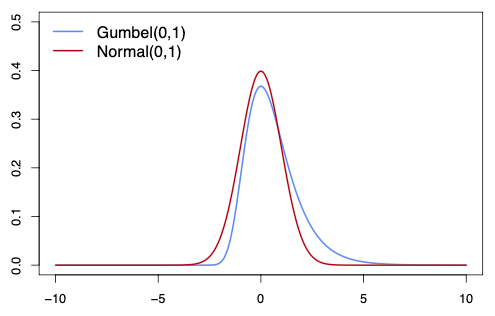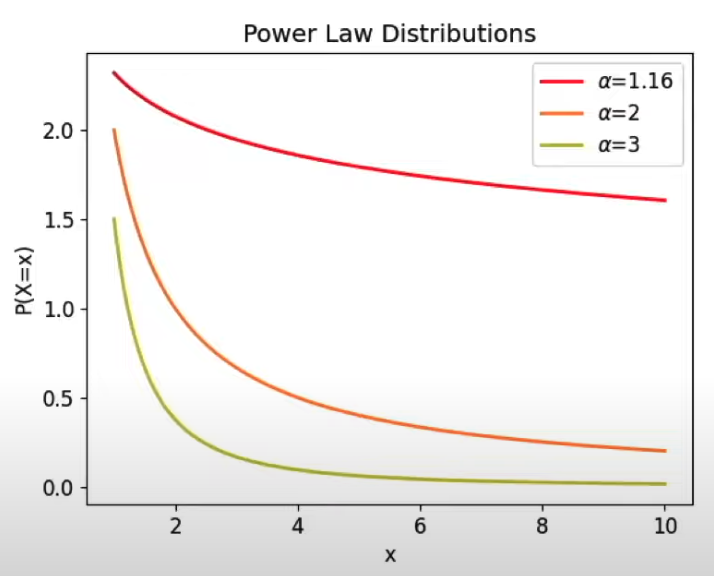Continuous Random Variable¶
takes value on a continuum of scale, ie, can take any decimal value
PDF¶
\[ \begin{aligned} f(x) &\ge 0 \\ \int f(x) \ \mathrm{d} x &= 1 \end{aligned} \]
CDF¶
\[ \begin{aligned} F(x) &= P(X \le x) \\ &= \int\limits_{- \infty}^x f(x) \ \mathrm{d} x \\ P(a \le X \le b) &= P(a < x < b) \\ &= \int\limits_a^b f(x) \ \mathrm{d} x \end{aligned} \]
Terms¶
| Formula | |
|---|---|
| \(E(x)\) | \(\int x \cdot f(x) \ \mathrm{d} x\) |
| \(E(x^2)\) | \(\int x^2 \cdot f(x) \ \mathrm{d} x\) |
(others are the same as discrete)
Distributions¶
| Distribution | Comment | \(f(x)\) | \(\mu\) | \(\sigma^2(x)\) | Skewness | Kurtosis | Modality | Symmetry | Diagram | ||
|---|---|---|---|---|---|---|---|---|---|---|---|
| Uniform | \(\begin{cases} \frac 1 {B-A} & A \le x \le B \\ 0 & \text{elsewhere} \end{cases}\) | \(\dfrac {B+A} 2\) | \(\dfrac 1 {12} (B-A)^2\) | ✅ | |||||||
| Normal/ Gaussian/ Bell-Curve/ \(z\) | \(\dfrac {1}{\sigma \sqrt{2\pi}} \exp \left\{ \dfrac {-1}{2} \left(\dfrac{x-\mu}{\sigma} \right)^2 \right\}\) | \(\begin{aligned} P(x<k) &= P \left(z<\frac{k-\mu}{\text{SD}} \right) \\ P(x>k) &= P(x < -k) \end{aligned}\) | 0 | 1 | 0 | 3 | 1 | ✅ | |||
| Gumbel/Type 1 Extreme Value | Normal distribution with skew and fatter tails | \(\exp \Bigg[ - \exp \left( \dfrac{-(x-\mu)}{\sigma} \right ) \Bigg]\) | \(\mu + \sigma \gamma_e\) \(\gamma_e \approx 0.577\) (Euler’s constant) | \(\dfrac{\pi^2 \sigma^2}{6}\) |  | ||||||
| Log-Normal | Type of gumbel distribution | ||||||||||
| Student \(t\) | Tends to normal distribution for large dof | 0 | >1 | ✅ | |||||||
| Binomial \(\to\) Normal Approx | \(np \ge 10\) or \(n(1-p) \ge 10\) | Normal distribution | \(\begin{aligned} x' &= x \pm 0.5 \\ z &= \frac{x' - \mu}{\text{SD}} \end{aligned}\) | \(np\) | \(np(1-p)\) | ||||||
| Chi-Square \(\chi^2\) | PDF of \(\sum \limits_i N_i(0, 1)^2\), where \(N_i\) is independent of \(N_j, \ \forall i \ne j\) | DOF | 2 * DOF | ||||||||
| Gamma | time between \(n\) occurrences | \(\dfrac{1}{B^\alpha \lceil\alpha} \cdot x^{\alpha-1} \cdot \exp \left(\dfrac{-x}{\beta} \right)\) | \(\alpha \beta\) | \(\alpha \beta^2\) | |||||||
| Exponential | time between successive/consecutive | \(\lambda \cdot \exp(-\lambda x)\) | \(\dfrac 1 \lambda = \beta\) | \(\dfrac 1 {\lambda^2} = \beta^2\) | |||||||
| Power Law | \(L(x) \cdot x^{-(\alpha-1)}; x > x_\min\) |  | |||||||||
| Pareto | Power law with \(\alpha =1.16\) Average value of those whose value is greater than \(y\) is \(y\) times the constant \(\lambda/(\lambda-1)\) \(\lambda\) controls the thickness of tail | \(P(X > x) = \begin{cases} (x_m/x)^\lambda, & x \ge x_m \\ 1, & x < x_m \end{cases}\) Top \(q\)th percentiles share = \((q/100)^{(\lambda-1)/\lambda}\) | \(1 - F(x) = \bar F(x) = P(X>x)\) | Size distribution Sizes of cities Income Family names Popularity Social network patterns Crime per convict Sizes of large earthquakes Power outages | |||||||
| Zipf | Pareto with \(\lambda=1\) | Empirical city size Firm size Equivalent to relationship of slope of -1 between log rank of city (based on city size) and log of population |
- DOF = Degrees of freedom
- \(n\) for sampling
-
\(n-k-1\) for regression
-
\(\lambda\) = mean no of occurances per unit time \(\lambda = \alpha\text{(poisson)}\)
- \(\beta\) = mean time b/w occurances \(\beta = \frac 1 \lambda = \frac 1 {\alpha\text{(poisson)}}\)
- \(\alpha\) = shape parameter it is the average number of occurrences of an event
Pareto Distribution